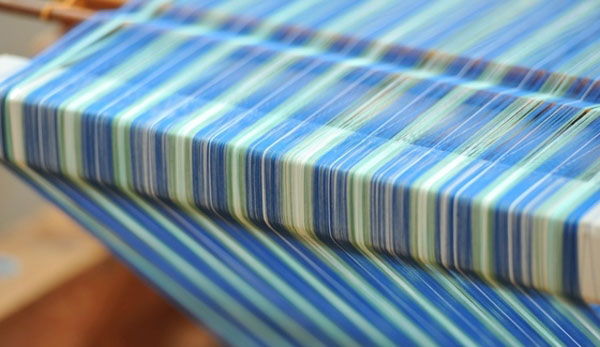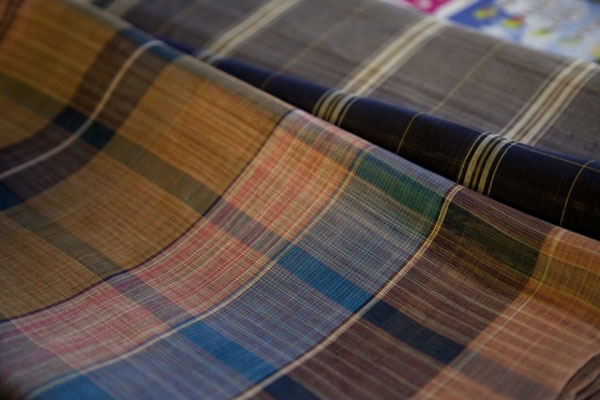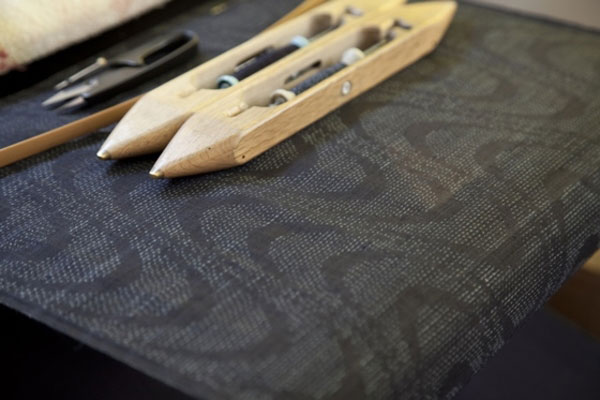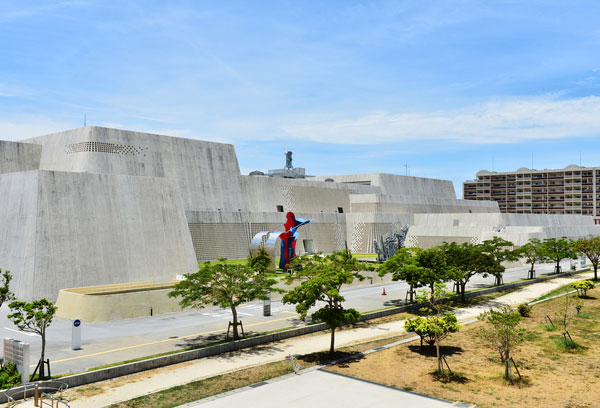 Photo:Okinawa Convention&Visitors Bureau
Photo:Okinawa Convention&Visitors Bureau
- Woven textiles
- Okinawa
Miyako ramie textile Miyako jofu
The smooth texture of ramie and a waxy luster
A delicate traditional textile from Okinawa
Description
What is Miyako ramie textile ?
Miyako jofu is a textile produced on the island of Miyakojima, Okinawa prefecture. It is woven from a fabric called ramie and dyed with Ryukyu indigo, a type of indigo native to Okinawa. This textile has a fine kasuri pattern* and a smooth and lustrous texture with a waxy appearance. The fibers for the fine threads are individually pulled out from the ramie plant by hand. As a result, textile woven with these threads has a good air permeability and is strong enough to last for three generations.
The ramie plant, which belongs to the nettle family and is a perennial plant, has long been native to Okinawa. It grows in approximately forty days and can be harvested around five times a year. It is not unusual that the production process will take a few years from initial stage of spinning threads to completing a roll of textile. A tie-dye method is used to repeatedly dye the warp threads with Ryukyu indigo and at least 1120 threads are used to form the warp thread. Weaving takes more than three months and when the textile is woven, once can see a tortoise shell or flower pattern emerging in a fine white kasuri pattern. This craft has a soft and lustrous texture from being hammered, which is the final production step.
Miyako ramie is one of Japan's four major fiber textiles. As a high quality indigo dye textile, it has been designated as an Important Intangible Cultural Asset of Japan.
*A kasuri pattern is precise patterning and images that result from wrapping fibers in thread in order to specifically dye the fabric.
History
 Photo:Okinawa Convention&Visitors Bureau
Photo:Okinawa Convention&Visitors Bureau
It is believed that textiles using ramie plant have been produced in Miyakojima since the 15th century. About four hundred years ago, a Ryukyu Kingdom (current day Okinawa) ship full of gifts for the Chinese Ming dynasty (1368-1644) was about to sink due to the damage caused by a severe typhoon when a man from Miyakojima dived into the sea and repaired the ship. Thanks to the bravery of the man, all of the ship's passengers were saved. The king of Ryukyu praised the man and assigned him to be a funeral priest. The man's wife was so pleased that she presented a textile to the royal government and this is said to have been the start of Miyako jofu. Afterward, it was presented to the Ryukyu government for about twenty years.
The Satsuma domain (current day Kagoshima prefecture) started to rule Ryukyu in 1609 and they introduced a poll tax from the year 1637. So, it became a responsibility of the Ryukyu women to produce Miyako ramie textile and present it to the Satsuma government as tax payment. Produced under the strict supervision of government officers, it became widely-known as a delicate and high quality textile called Satsuma jofu. When the poll tax was abolished, a textile association was formed to prevent the quality of the textile from deteriorating. They kept the quality of the textile as high as possible. The production peak was from the Taisho period (1912-1926) until the beginning of the Showa period (1926-1989). Production of Miyako ramie textile declined after World War II when Okinawa started being governed by the United States. Currently, the people of Okinawa are putting efforts toward developing successors who will carry on production of the textile using traditional techniques.
General Production Process
 Photo:Okinawa Convention&Visitors Bureau
Photo:Okinawa Convention&Visitors Bureau
- 1. Taking fiber from the ramie plant
This textile uses threads made from the ramie plant which belongs to the nettle family. Ramie is not strong against the wind so it should be cultivated where there is less wind, for example, in the backyard of a house and also it should be without the use of chemical fertilizers. After about forty days, the ramie becomes taller than 150 cm (about 4 ft 9 in) and then it is ready to be cropped. The plant should be cropped just above the root, the leaves should be taken off, and the surface bark of the stalk should be peeled off. Then, the inside of the stalk except for the fiber is scraped off using an abalone shell in a process that is unique to this region. The ramie plant can be cropped four to five times a year but the best crop is grown in the early summer between May and June. The fiber is washed in water and dried in the shade.
- 2. Making threads by hand
Fine thread is made by hand ripping the fiber taken from ramie plants. The warp (parallel) and weft (perpendicular) threads are both hand-spun which requires great patience. The warp threads are shredded to the thickness of human hair and twisted (not knotted) into one thread. Then the thread is twisted using a spinning wheel into one thread. The weft threads are made of twisted single threads. It takes more than three months to spin enough threads for one roll of the textile. This is an important process that determines the texture of the fabric.
- 3. Designing and preventing dyeing
The kasuri pattern is planned and drawn on graph paper. Kasuri lumping, the manually binding of fabric with thread to prevent dyeing, is the technique used to create the patterns. After the amount of thread needed for the textile has been determined, the cotton thread is starched to prevent the pattern placement from slipping. When the thread is dry, it is used to tie the fabric that is not meant to be dyed. As kasuri patterns are tiny, a machine is used to tie the threads. After they have been tied, the threads are washed to remove the starch so that the dye will be applied evenly.
- 4. Dyeing the threads
For this textile, Ryukyu indigo is cultivated in Izumi on Okinawa Island. The mud-like indigo is put in a plastic container. Then, caustic soda and awamori (Okinawan liquor) or brown cane sugar are stirred into the indigo. The mixture has to be blended well then left alone for one to two weeks, being stirred daily during that time. When the mixture is fermented, it produces a foam called the flower of indigo. The cotton threads and the base fabric are put in this liquid dye. The indigo oxidizes after being exposed to air, making the color emerge. This is why the threads are soaked and then taken out to be exposed to air repeatedly. This process of soaking the threads in the liquid dye and taking them out to expose to air has to be repeated approximately twenty times until the color of the thread becomes deep enough. After the color of the threads is deep enough, they are wrung and placed out in the sun to dry for four to five hours.
- 5. Temporarily putting threads through reed
After dyeing, the ties on the threads are removed. Then the threads are washed thoroughly and dried. When the threads are dry, each one is individually put through the temporary reed in accordance with the design.
- 6. Weaving
After the threads have been put through the temporary reed, they are wound and put through the eye of the heddle. After that, they are put through the actual reed. The weaver starts weaving slowly and carefully. The warp pattern is adjusted using a needle so that the kasuri patterns do not appear in the wrong position. Even an experienced weaver can weave only 20 cm (about 7.8 in) or so a day.
- 7. Hammering the cloth
After weaving is complete, the textile is washed and dried in the shade. When it is dry, both sides of the textile are starched using the starch from potato scraps. The textile is folded to a small size, spread over a wooden stand, and hammered for about three hours using a wooden hammer as heavy as 4 kg (8.8 lbs). Through hammering, the textile gains a smooth wax-like texture.
Where to Buy & More Information
Okinawa Prefectural Museum & Art Museum

-
Address
-
Tel.+81-98-941-8200
-
ClosedMondays (open if Monday is holiday and closed the next day), December 29 - 31
-
Business Hours9am to 6pm Fridays & Saturdays 9am to 8pm
-
Website
See more Woven textiles
- Nishijin brocade
- Yuki tsumugi silk
- Kurume traditional resist-dyed textiles
- Ojiya chijimi textiles
- Hakata brocade
- Ushikubi tsumugi silk
- Chichibu-meisen silk
- Miyako ramie textile
- Shiozawa tsumugi silk
- Kumejima tsumugi silk
- Omi ramie cloth
- Ryukyu traditional resist-dyed textiles
- Kiryu brocade
- Murayama-oshima tsumugi silk
- Yumihama traditional resist-dyed textiles
- Chibana-hanaori textiles
- Hon-shiozawa silk
- Oitama tsumugi silk
- Ojiya tsumugi silk
- Yaeyama cotton cloth
- Yaeyama ramie cloth
- Honba oshima tsumugi silk
- Shinshu tsumugi silk
- Shuri brocade
- Tama brocade
- Yomitanzan-hanaori textiles
- Isesaki traditional resist-dyed textiles
- Hachio island silk
- Nibutani bark cloth
- Uetsu tilia bark cloth
- Awa-shijira cotton cloth
- Kijoka banana fiber cloth
- Tokamachi traditional resist-dyed textiles
- Tokamachi akashi chijimi textiles
- Yonaguni brocade
- Yuntanza minsa
- Flower pattern textiles
- Oku-Aizu Showa Karamushi Textiles
See items made in Okinawa
- Tsuboya ware
- Miyako ramie textile
- Ryukyu lacquerware
- Kumejima tsumugi silk
- Ryukyu traditional resist-dyed textiles
- Chibana-hanaori textiles
- Yaeyama cotton cloth
- Yaeyama ramie cloth
- Shuri brocade
- Yomitanzan-hanaori textiles
- Ryukyu traditional textiles
- Kijoka banana fiber cloth
- Yonaguni brocade
- Yuntanza minsa
- Flower pattern textiles
- Sanshin































































































































































































































































































